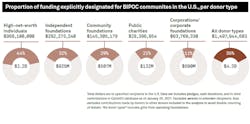Report finds that more than $20 billion went to COVID-19 philanthropy in 2020
Candid and the Center for Disaster Philanthropy (CDP) released a new report, Philanthropy and COVID-19: Measuring one year of giving, that examines COVID-19-related philanthropic funding in 2020, which identified $20.2 billion in global COVID-19 giving by grant-makers and wealthy donors for 2020.
It is the second of two reports assessing COVID-19 philanthropic data. The first report, released in August 2020, examined COVID-19 philanthropy in the first half of 2020. The new report provides updates and looks at the global philanthropic response to COVID-19 for all of 2020. After the World Health Organization’s (WHO’s) declaration of the COVID-19 pandemic on March 11, 2020, corporations, foundations, public charities, and high-net-worth individuals increased giving that continued throughout the rest of the year. Closer examination of the data reveals:
· Corporate foundations and corporate giving programs accounted for $9.4 billion (44%) of total COVID-19 funding in 2020.
· Community foundations awarded more grants than any other grant-maker type, making up 54% of total awards.
· Funding by independent foundations more than doubled, increasing from $1.7 billion in the first half of the year to $4.7 billion for the entire year.
· High-net-worth donors accounted for $5.8 billion, more than one-quarter of total philanthropic funding. MacKenzie Scott’s grants accounted for nearly three-quarters of funding from high-net-worth individuals.
· Human services organizations received the most support, followed by health organizations. In the first half of 2020, health organizations received the most support, followed by public safety organizations.
The majority of funding dollars ($13.5 billion, around 63%) went to “unknown” recipients or to “multiple” recipients. Funding designated for specific populations provided some encouraging updates, particularly regarding Black, Indigenous, and people of color (BIPOC) communities. In the first half of 2020, only 5% of COVID-19-related funding that specified recipients was designated for BIPOC communities, despite these populations being disproportionately affected by the pandemic. Since then, available data shows a dramatic increase:
· 23% of specified global funding was explicitly designated for communities of color.
· 35% of specified U.S. funding was designated for BIPOC communities.
· High-net-worth donors designated the highest proportion of funding for BIPOC communities (44%), whereas corporations accounted for only 11% of funding designated for BIPOC communities.
· Additionally, 8% of funding was directed explicitly for people with disabilities, an increase from 1% reported in the first report. In contrast, funding specified for women and girls increased nominally, from 3% in the first half of 2020 to 4% for the entire year.
Funding directed to immigrants and refugees remained at 2%, and funding specified for older adults also remained at 2%. Grace Sato, director of research at Candid, says, “After the first report, there were questions about whether philanthropic funding would taper down. What we see is exactly the opposite—not only did funding stay strong throughout the rest of the year, but we also see promising trends in several categories. It shows that philanthropy can, and is, playing an especially important role in times of crisis.”
The report shows that there has also been a notable effort to support nonprofits. The first report documented 3% of dollars for general support. By the end of 2020, 39% of dollars and 21% of gifts to specified recipients were described as unrestricted or flexible.
Even so, analysis shows that, the nonprofit sector lost nearly 930,000 jobs since the beginning of the pandemic. Although most organizations are positioned to survive a short recession, a longer one could be devastating. Philanthropy will continue to play an essential role in supporting nonprofits and NGOs so that they’re equipped to provide important resources and services to communities worldwide.
Regine A. Webster, vice president at CDP, says, “Even as we see signs that the U.S. may be turning the corner in this pandemic, recovery from this disaster is a long process that will take years. This is only the beginning. We need philanthropy to continue stepping up in support of nonprofits and NGOs providing vital resources to communities, especially those most affected by COVID-19 globally. We hope this report informs and motivates donors to discover how they can make the greatest impact with their disaster-related giving this year and beyond.”
CDP recommends several ways donors can work toward equitable recovery from COVID-19:
· Sustain or increase giving and make unrestricted and flexible grants
· Trust your grant partner and support operational and administrative costs
· Target funding to communities that are systemically marginalized and disproportionately affected by COVID-19
· Make grants outside of traditional grantmaking circles
· Report funding data to Candid and ensure that grant descriptions are clear and explicit Philanthropy and COVID-19: Measuring one year of giving is available at http://doi.org/10/gh5dzk.
